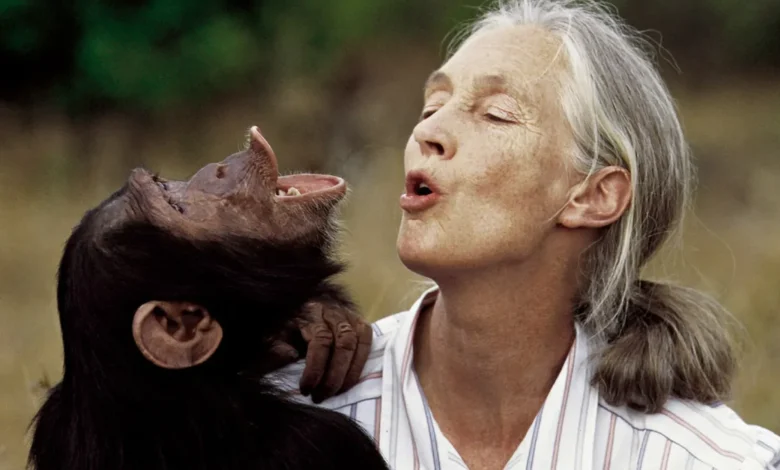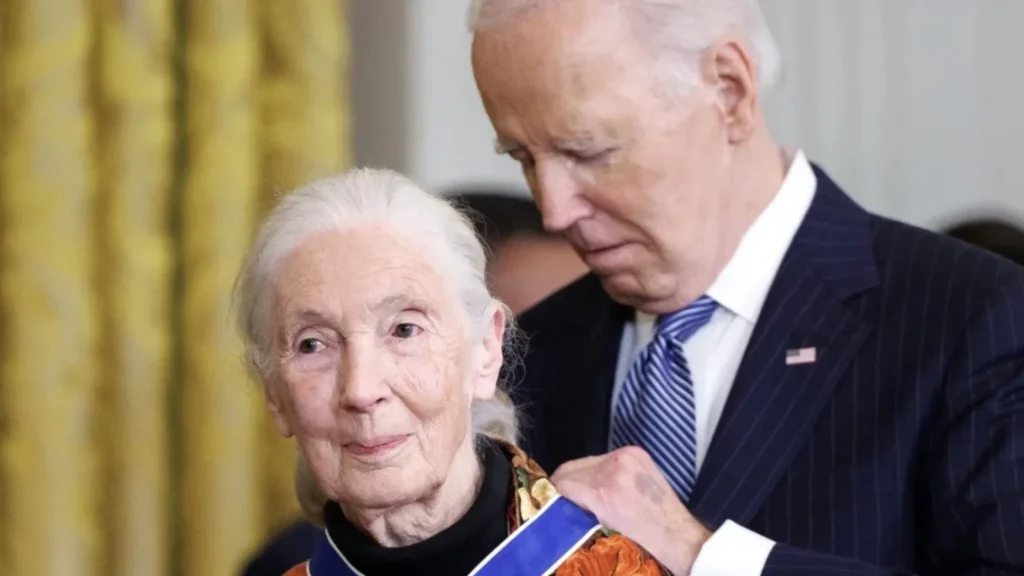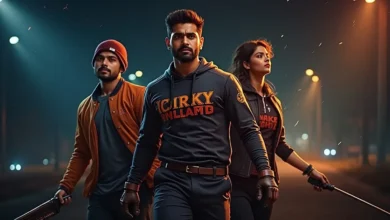How Jane Goodall’s Inspiring Journey Redefined Wildlife Conservation

Jane Goodall changed how we see animals. She spent her life watching chimpanzees. Born in 1934, she grew up loving nature. In 1960, she went to Africa. There, she made big finds. Chimps use tools and feel emotions. This shocked scientists.
Jane started as a young woman with no degree. She became a top primatologist. Her work led to saving forests and animals. She founded groups to help. Kids join her programs worldwide. Jane wrote books and gave talks. She won many awards.
Sadly, she passed away in 2025 at 91. But her ideas live on. We learn from her to care for Earth. Her story shows one person can make change. Let’s look at her life and work. From chimp studies to global help. Jane Goodall inspires us all.
Early Days and Path to Primatology
Jane Goodall loved animals as a kid. She was born in London on April 3, 1934. Her mom gave her a toy chimp named Jubilee. That sparked her dream. She read books about wild places. At 18, she worked jobs to save money. She sailed to Kenya in 1957. There, she met Louis Leakey. He studied old bones. Leakey saw her smarts. He sent her to watch chimps in Tanzania.
In 1960, Jane started at Gombe Park. She had no college degree yet. But she watched closely. She named the chimps. Like David Greybeard. This helped her learn their ways. She got a PhD later in 1965. Her thesis was on chimp behavior. This start changed science. For example, she lived in the forest alone at first. Her mom joined later for safety.
Moreover, she faced doubts. Men led the field then. But she proved them wrong. Her passion drove her. Tip: Follow your dreams like she did. Start small. Watch nature near you.
Key Finds About Chimpanzees
Jane Goodall made big discoveries. She saw chimps use tools first. In 1960, she watched David Greybeard. He poked a stick into a termite hill. He ate the bugs that stuck. This showed chimps make tools. Before, people thought only humans did that. Leakey said we must rethink what makes us human.
Chimps also eat meat. She saw them hunt monkeys. They work as a team. This proved they are not just plant eaters. Her notes showed chimps have feelings. They hug and kiss. They get sad when friends die. For instance, one mom carried her dead baby for days.
However, she saw dark sides too. Chimps fight wars. In Gombe, groups killed each other. This mirrored human acts. Jane Goodall’s work lasted 65 years. It gave over 500 science papers. Her finds help save chimps today.
Tool Use and Smarts
Chimps show brains like ours. She saw them strip leaves off twigs. They make fishing rods for bugs. They use rocks to crack nuts. This takes skill. Kids learn from moms. It’s like school.
One case: A chimp used a leaf as a sponge. He soaked up water to drink. Jane Goodall noted this in her books. It shows planning. Tip: Watch animals in zoos. See if they use tools.
Social Lives and Feelings
Chimps live in groups. She called them families. Males lead. But females bond strongly. They groom each other. This builds trust. She saw joy in play. And anger in fights.
A sad story: Flo’s baby died. Flo mourned. This proved my emotions. Jane said chimps feel like us. This changed how we treat animals.

Building the Jane Goodall Institute
In 1977, she started her institute. It’s called the Jane Goodall Institute. It helps chimps and forests. At first, it funded Gombe research. Now, it has 25 offices worldwide. They protect habitats. Over millions of acres under plans.
The institute helps people too. In Africa, they teach farming. This stops cutting trees. For example, the Tacare program aids villages. Women learn health. Girls go to school. This cuts poverty. Chimps get safe homes.
Moreover, sanctuaries save orphans. Like Tchimpounga in Congo. It cares for over 100 chimps. She visited often. Her group uses tech. Satellites track forests. This fights illegal logging.
Tip: Join local groups. Plant trees. Help like the institute does.
Roots & Shoots for Young Helpers
Jane Goodall wanted kids to act. In 1991, she started Roots & Shoots. It began with 12 teens in Tanzania. Now, it’s in 75 countries. Over 10,000 groups. Kids pick projects. For animals, people, or Earth.
For instance, a group cleans beaches. Another saves bees. Jane Goodall said youth have power. They see problems fresh. The program teaches hope. “Every day you make an impact,” she quoted.
However, it grows big. Schools join. Kids lead. Jane Goodall spoke to them. Her message: Small acts add up. Tip: Start a club. Pick a cause. Make change.
Books, Talks, and Films
Jane Goodall shared her story widely. She wrote over 27 books. “In the Shadow of Man” from 1971 sold millions. It’s in 48 languages. It tells Gombe tales. Kids books like “My Life with the Chimpanzees” inspire young readers.
She gave TED talks. One in 2007: “What separates us from chimpanzees?” It has millions of views. She said the big difference is human talk. But chimps are close kin. Another in 2020: “Every day you impact the planet.” She urged care.
Documentaries show her work. National Geographic films like “Jane” in 2017. It uses old footage. Jane Goodall was in IMAX movies too. Her speeches reached leaders. She talked at UN events.
Moreover, quotes guide us. “The greatest danger is apathy.” Or “Change happens by listening.” Tip: Read her books. Watch talks. Learn from her words.

Awards and World Praise
Jane Goodall won top honors.UN made her a Messenger of Peace in 2002. In 2004, she became Dame Jane. The Queen gave her that. France’s Legion of Honour came too. Japan’s Kyoto Prize for science.
In 2021, Templeton Prize for spirit and science mix. In 2025, the US President gave her the Medal of Freedom. It’s the top civilian award. She got the Gandhi-King Award for peace.
Time magazine called her influential in 2019. Disney honored her at Animal Kingdom. A tree is carved there. Jane Goodall got over 50 doctor degrees. Her work touched hearts.
However, she stayed humble. Awards helped her cause. Tip: Honor helpers in your life. Give thanks.
Her Lasting Mark on Earth
Jane Goodall’s legacy shines. She saved chimps from extinction. Her institute protects forests. Roots & Shoots trains future leaders. Science changed because of her. We see animals as kin now.
Her impact: Chimp habitats grew safe. Laws ban testing on them. People eat less meat thanks to her. She went vegan in 2021. Her book “Eat Meat Less” shares tips.
After her passing in 2025, tributes came. Prince Harry praised her. UN leaders too. Netflix made “Famous Last Words” about her. Jane Goodall lived with hope. She said nature bounces back.
Moreover, her family carries on. My son and grandkids help. Her work inspires balance with nature.
Jane Goodall showed us how to live kindly. She watched chimps and learned deep. Her eyes opened. Now, we protect better. Join her way. Start today. Help animals. Plant a tree. Read her story. Make your impact good. What will you do next? Visit her institute site. Get involved. Her spirit guides us.
FAQs
Why is Jane Goodall famous, and who is she?
Jane Goodall is a primatologist who studied chimps. She found they use tools and have feelings. This made her famous. She fought for nature too.
What did Jane Goodall discover about chimpanzees?
She saw chimps make tools from sticks. They hunt meat and show emotions. This proved they are smart like us.
How Jane Goodall changed animal research?
She named animals and lived with them. This made studies more kind. Scientists follow her way now.
Jane Goodall quotes about animals and nature?
“The greatest danger to our future is apathy.” “You make an impact every day.”
Jane Goodall contribution to science and conservation?
She wrote books and started groups. Her work saves forests and teaches kids to help Earth.
Key Citations
- Jane Goodall Institute Official Site: https://janegoodall.org/
- Wikipedia – Jane Goodall: https://en.wikipedia.org/wiki/Jane_Goodall
- National Geographic – Jane Goodall: https://education.nationalgeographic.org/resource/jane-goodall/
- Nature – Jane Goodall’s Legacy: https://www.nature.com/articles/d41586-025-03209-y
- Biography.com – Jane Goodall: https://www.biography.com/scientists/jane-goodall
- TED Talks – Jane Goodall: https://www.ted.com/speakers/jane_goodall
- Britannica – Jane Goodall: https://www.britannica.com/biography/Jane-Goodall
- Scientific American – Jane Goodall: https://www.scientificamerican.com/article/jane-goodall-conservationist-who-transformed-our-understanding-of/
- Live Science – Jane Goodall Discoveries: https://www.livescience.com/animals/land-mammals/from-tool-use-to-warfare-here-are-5-ways-jane-goodall-revolutionized-our-knowledge-of-chimpanzees
- Goodreads – Jane Goodall Quotes: https://www.goodreads.com/author/quotes/18163.Jane_Goodall
- Mongabay – Jane Goodall Obituary: https://news.mongabay.com/2025/10/jane-goodall-1934-2025-primatologist-conservationist-and-messenger-of-hope/
- Reuters – Conservation Impact: https://www.reuters.com/business/environment/jane-goodalls-death-highlights-narrow-window-conservation-2025-10-03/
- AP News – Tributes: https://apnews.com/article/jane-goodall-reactions-death-df8170c447eae2ea68855039b86c6e95



